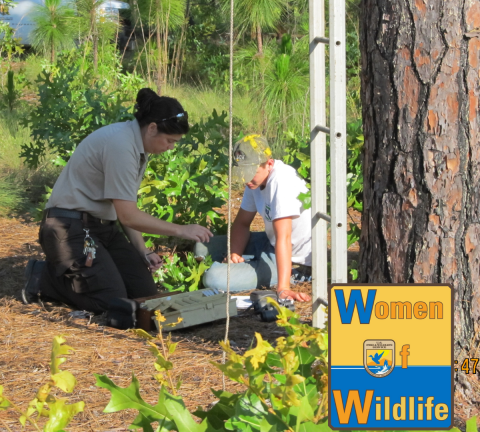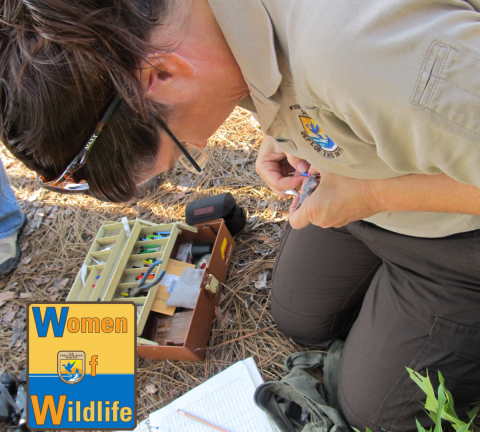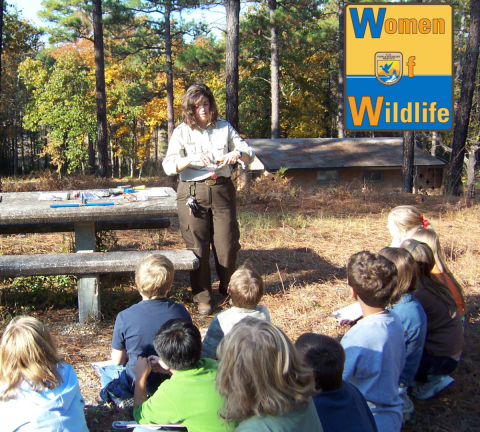Allyne Askins, refuge manager of Carolina Sandhills National Wildlife Refuge Complex, studied pre-law at Furman University. During her junior year, she took a biology class to meet her science requirement and found her passion. That spring she served as an environmental legislative assistant to Elizabeth Patterson, then a U.S. Representative from South Carolina. Allyne knew she needed to learn more about natural resources to be an effective advocate so she returned to Furman for her senior year and took 24 hours of biology classes. A new career path was launched.
For nearly 17 years, Allyne has managed Carolina Sandhills National Wildlife Refuge Complex. Allyne joined the Fish and Wildlife Service in October 1998 as the assistant refuge manager at Lower Suwannee and Cedar Keys NWR. In 2001, she became the refuge manager of Bon Secour National Wildlife Refuge where she served until 2004 when she became a refuge manager of the Savannah Coastal Refuge Complex, responsible for Harris Neck, Blackbeard Island, Wassaw Island, and Wolf Island National Wildlife Refuges. She moved to the Carolina Sandhills National Wildlife Refuge in 2006.
Allyne obtained her masters degree in forest resources at Clemson University where she studied southern flying squirrel use of red-cockaded woodpecker habitat at the Savannah River Site in Aiken, South Carolina. This led to her first natural resources position as a red-cockaded woodpecker biologist with the South Carolina Department of Natural Resources.
At Carolina Sandhills National Wildlife Refuge Complex, Allyne supervises nine employees at the 47,850-acre Carolina Sandhills Refuge, headquartered in McBee, South Carolina, and two employees at the 8,443-acre Pee Dee National Wildlife Refuge in Wadesboro, North Carolina.
She was involved in recruiting and/or hiring nine of her 11 staff members.
“I am blessed to work alongside a crew of folks that passionately believes in our purpose, goals and mission,” Allyne says of her staff. “I find myself advocating for them and ensuring they have the resources needed to do their jobs while trying to stay out of their way! To the extent possible, I try to deal with administrivia and bureaucracy so they can keep providing conservation delivery on the ground.”
Carolina Sandhills hosts the largest population of red-cockaded woodpeckers on Service lands with 162 potential breeding groups. In partnership with neighboring Sand Hills State Forest and Cheraw State Park, the refuge has attained the status of a secondary core recovery population. This means the area can potentially host at least 250 breeding groups at or after the time of delisting. That population size is the minimum estimate considered necessary to avoid threats of extinction from catastrophic environmental events, such as hurricanes.
Allyne proudly mentions the refuge’s rebranding under her watch.
"When I arrived, we were known as the woodpecker refuge,” she says. “We have worked deliberately over that last 15 years to tell the conservation story of the refuge’s landscape – the imperiled longleaf pine and wiregrass ecosystem that is home to nearly 200 species of birds, 108 species of mammals, reptiles, and amphibians, and more than 1,000 species of plants. We have hosted additional research on sandy ants, burying beetles, Lepidoptera, and solitary bees. By managing the ecosystem, not a single species, we have truly achieved conservation success.”
She and her staff members have taught students tasks at the refuge like red-cockaded woodpecker banding. Allyne urges students to volunteer to gain experience.
“The job market is extremely competitive,” says Allyne. “By volunteering you not only gain skills that you otherwise would not have, but you network and make connections that may open doors in the future. Prior to joining the Service, I volunteered at Carolina Sandhills National Wildlife Refuge and helped with many things: deer check station, red-cockaded woodpecker monitoring and translocations, cruising timber, and public use events. The manager of the refuge at the time, Ricky Ingram, provided a recommendation for my first Service job.”
Not only did Allyne eventually become the manager of the refuge where she once volunteered, Ricky Ingram also introduced her to her husband of 28 years, Greg Askins. He also works for the Service as a Prescribed Fire Specialist for the Southeast Region’s Fire-East Zone. They have two sons, Zach and Josh, who both love hunting, fishing, and national wildlife refuges. “It’s part of their DNA,” says Allyne. In her spare time, Allyne also enjoys playing tennis, cooking, and traveling.
An early change in her career goals led Allyne to her life’s work and family.
Editor’s note: During Women’s History Month, the U.S. Fish and Wildlife Service celebrates the accomplishments and commitment of women throughout the organization. The Women of Wildlife, or WOW, story series highlights some of the women serving in the Southeast Region.








